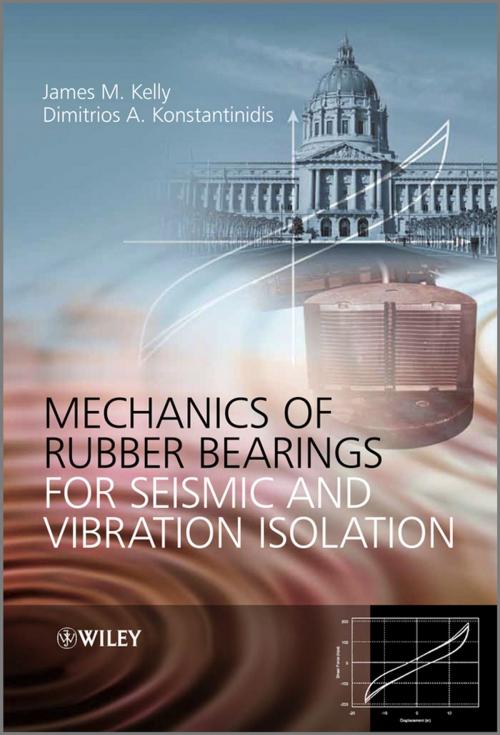Mechanics of Rubber Bearings for Seismic and Vibration Isolation
Nonfiction, Science & Nature, Technology, Engineering, Civil| Author: | James M. Kelly, Dimitrios Konstantinidis | ISBN: | 9781119972808 |
| Publisher: | Wiley | Publication: | August 24, 2011 |
| Imprint: | Wiley | Language: | English |
| Author: | James M. Kelly, Dimitrios Konstantinidis |
| ISBN: | 9781119972808 |
| Publisher: | Wiley |
| Publication: | August 24, 2011 |
| Imprint: | Wiley |
| Language: | English |
Widely used in civil, mechanical and automotive engineering since the early 1980s, multilayer rubber bearings have been used as seismic isolation devices for buildings in highly seismic areas in many countries. Their appeal in these applications comes from their ability to provide a component with high stiffness in one direction with high flexibility in one or more orthogonal directions. This combination of vertical stiffness with horizontal flexibility, achieved by reinforcing the rubber by thin steel shims perpendicular to the vertical load, enables them to be used as seismic and vibration isolators for machinery, buildings and bridges.
Mechanics of Rubber Bearings for Seismic and Vibration Isolation collates the most important information on the mechanics of multilayer rubber bearings. It explores a unique and comprehensive combination of relevant topics, covering all prerequisite fundamental theory and providing a number of closed-form solutions to various boundary value problems as well as a comprehensive historical overview on the use of isolation.
Many of the results presented in the book are new and are essential for a proper understanding of the behavior of these bearings and for the design and analysis of vibration or seismic isolation systems. The advantages afforded by adopting these natural rubber systems is clearly explained to designers and users of this technology, bringing into focus the design and specification of bearings for buildings, bridges and industrial structures.
This comprehensive book:
- includes state of the art, as yet unpublished research along with all required fundamental concepts;
- is authored by world-leading experts with over 40 years of combined experience on seismic isolation and the behavior of multilayer rubber bearings;
- is accompanied by a website at www.wiley.com/go/kelly
The concise approach of Mechanics of Rubber Bearings for Seismic and Vibration Isolation forms an invaluable resource for graduate students and researchers/practitioners in structural and mechanical engineering departments, in particular those working in seismic and vibration isolation.
Widely used in civil, mechanical and automotive engineering since the early 1980s, multilayer rubber bearings have been used as seismic isolation devices for buildings in highly seismic areas in many countries. Their appeal in these applications comes from their ability to provide a component with high stiffness in one direction with high flexibility in one or more orthogonal directions. This combination of vertical stiffness with horizontal flexibility, achieved by reinforcing the rubber by thin steel shims perpendicular to the vertical load, enables them to be used as seismic and vibration isolators for machinery, buildings and bridges.
Mechanics of Rubber Bearings for Seismic and Vibration Isolation collates the most important information on the mechanics of multilayer rubber bearings. It explores a unique and comprehensive combination of relevant topics, covering all prerequisite fundamental theory and providing a number of closed-form solutions to various boundary value problems as well as a comprehensive historical overview on the use of isolation.
Many of the results presented in the book are new and are essential for a proper understanding of the behavior of these bearings and for the design and analysis of vibration or seismic isolation systems. The advantages afforded by adopting these natural rubber systems is clearly explained to designers and users of this technology, bringing into focus the design and specification of bearings for buildings, bridges and industrial structures.
This comprehensive book:
- includes state of the art, as yet unpublished research along with all required fundamental concepts;
- is authored by world-leading experts with over 40 years of combined experience on seismic isolation and the behavior of multilayer rubber bearings;
- is accompanied by a website at www.wiley.com/go/kelly
The concise approach of Mechanics of Rubber Bearings for Seismic and Vibration Isolation forms an invaluable resource for graduate students and researchers/practitioners in structural and mechanical engineering departments, in particular those working in seismic and vibration isolation.















